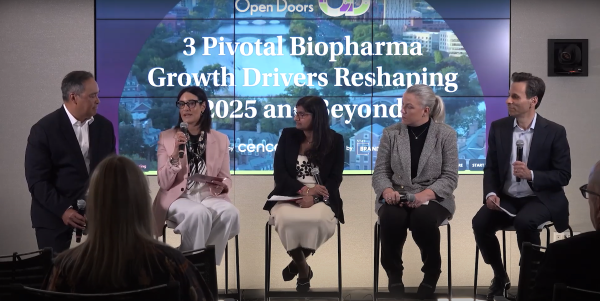Optimizing the channel strategy to expand patient access to cell and gene therapies

By: Melissa Lattanzi

Product innovation brings new treatment hope to patients in need, including potentially transformative cell and gene therapies for rare diseases. To successfully bring these life-changing or life-saving therapies to patients, companies will need to develop a well-planned channel strategy.
During Cencora’s ThinkLive Cell and Gene Therapy Summit 2024 – “Beyond borders: Breaking barriers to enhance patient access in cell and gene therapy” – discussion in the early sessions focused on building a channel strategy to address cell and gene therapy-specific barriers. The article provides highlights from a presentation from Melissa Lattanzi, Vice President, Emerging Therapies, at Cencora, followed by a panel discussion chaired by Melissa with Morgan Marr, National Director, Trade, Ferring Pharmaceuticals and Susan Weidner, Senior VP, Intrinsiq Speciality Solutions, at Cencora.

Patients first
In her presentation, Melissa shared key considerations around the needs of the patient. Where and how are they being treated? Which physician specialties are they seeing? Do they have comorbidities that impact treatment? Some rare conditions present in a variety of ways, so the patient might be seen by a number of different specialists.
It’s also important to consider how and where therapies are being administered, she noted. Are they filling a script at a pharmacy and going home? Are they getting treatment within the physician practice? Are they being seen in the community? Or are they being seen at a local hospital or traveling to a Center of Excellence or a specific specialist? That can occur if the practice the patient attends can’t support buy and bill for the product – which is where the practice is responsible for the upfront costs of purchasing a product for in-office administration.
Understanding the patient and provider landscape is key to helping patients that might benefit from a treatment to access it, and to help their physicians provide follow-up care.
“We are starting to see increased interest and awareness in
the health system generally and by community-based providers in accessing these
new therapies and implementing them in their current care setting,” Susan said,
and while there are challenges for community-based providers to access those
therapies, there has been increased adoption.
Tackling the logistics
Nevertheless, cell and gene therapies present some unique challenges . When it comes to storage, for example, many gene therapies require cold chain storage at -80°C while cell therapies typically requiring cryopreservation at temperatures below -140°C. This means having very specialized freezers or even having a cell therapy laboratory store the product, which might not always be practical for a clinic, Melissa stated.
At the same time, fresh cells have a special shipping and handling requirements, requiring tight coordination between manufacturing, the center and the patient . Autologous products also have chain of custody tracking requirements, so a facility will need to be able to manage that.
Cost is another key consideration, Melissa explained. As one-time treatments, these are expensive products, with one product costing $4.25 million for a single dose . Even if the site is familiar with buy and bill, it might not be comfortable at such a high price point.
There might be patient logistics to consider, for example, if they have to travel out of state. How the patient’s health plan deals with that can vary, which increases the risk for the facility with regards to reimbursement, Melissa explained. Some companies are making use of a specialty pharmacy, which can take on the reimbursement risk, allowing the site to focus on patient care .
Centers might also struggle with capacity and space constraints, since many are also treating patients in clinical trials. Additionally, there may be clinical considerations. Some therapies have to be administered via a surgical procedure, so the practice would have to be comfortable carrying those out.
Then there are adverse event management considerations. Does the center have a crash cart? Does the product need to be administered inpatient? Can it be given in a community setting or on an outpatient basis?
“The community setting often faces roadblocks from the payer perspective, because their interpretation of the package insert is that these therapies need to be delivered in an inpatient setting,” Susan said. “This requires us to demonstrate – through clinical trials or real-world evidence – the safety of providing these therapies in the community setting where the majority of patients are.”
Planning the market strategy
Once the centers willing and able to treat patients with a cell or gene therapy have been identified, companies should consider the size of the network, which will vary depending on the patient population.
For very rare diseases, it doesn’t make sense to have a large network of centers across the United States, but it is also important to consider geographical coverage so patients don’t have to travel too far, Melissa noted in her presentation.
Determine the right markets for a launch. After the US, companies might want to move into Europe, Canada, and Asia, for example. Understanding the potential logistical challenges and requirements in those markets is key when considering partners. The supply chain should also be top of mind, since it could impact where to place manufacturing facilities.
Additionally, think about how the strategy may evolve, not just in terms of market reach but also with regards to future indications or new product launches.
Keep an eye on the competitive landscape, Melissa advised. How might that impact the channel strategy? If a company’s network is too restrictive and that impacts access to a treatment, physicians may consider a competitor product for their patients.
With the launch of its gene therapy ADSTILADRIN®(nadofaragene firadenovec-vncg), a novel, non-replicating adenovirus vector-based gene therapy for the treatment of adult patients with high-risk, Bacillus Calmette-Guérin (BCG)-unresponsive non-muscle invasive bladder cancer (NMIBC) with carcinoma in situ (CIS) with or without papillary tumors, understanding from clinics that chose to participate in an early experience program was paramount for Ferring for the first 4 months post launch. “Therefore, we coordinated with each individual clinic to manage expectations and then align on how to best achieve a seamless customer and, most importantly, patient experience,” Morgan said.
Working with practices and partners
Engaging with sites early can help physicians understand a new therapy so they can better treat their patients. These centers can also provide feedback as to what works for them and what works for their patients. This can help companies to consider the types of support resources or onboarding processes. Early engagement can also provide insights on potential capacity constraints or cash flow issues.
During the panel discussion, Susan highlighted the importance of working with practices to implement cell and gene therapies, including educating their staff about new processes.
“It is a significant amount of investment on their part, and we have to be cognizant of the need to give them time to get up and going and then to be able to reinforce the process so they can repeat it as more such therapies become available,” she said.
Working with partners who have active relationships with these facilities can help to streamline the workflow and provide greater visibility on key issues such as pricing and resource requirements.
Prime vendor agreements can help to provide a more coordinated approach to access and delivery to the various sites of care, Susan said. “This gives a more consistent and transparent approach to these customers with where to go, where it is in the process and having the right financials so payment of these therapies is relative to the delivery of the treatment.”
Morgan emphasized the importance of distribution partner commitment with any therapies for rare conditions.
“You need to HCPs and Office Administrators to understand the medical benefit (versus the pharmacy benefit), share their knowledge with their peers, and maintain that sense of urgency to ensure timely patient care,” she said. With the ADSTILADRIN launch, the objective included 1. streamlining the product acquisition and other administrative processes, and 2. demonstrating that ADSTILADRIN instillation would facilitate patients staying with their urologists rather than having to move to an oncologist, and thus perhaps improving continuity of care. However, it did take time for those urologists to gain more experience with the product and to getting payers to cover pursuant to a general policy as opposed to evaluating on a patient-by-patient basis.
“Communicating with your distribution partners and field reimbursement team is key to understanding how each payer will approach contracting, and then leverage that knowledge,” she added.
Teamwork and education
During her presentation, Melissa emphasized the importance of working with cross-functional teams, across clinical and commercial both internally and externally, to address issues that might arise.
When partnering with providers in the community setting that may not have had experience with certain types of therapies, consider engaging with stakeholders that are already building frameworks around how these therapies will be adopted in the practice – for example, pharmacy and therapeutics committees and medical boards, Susan said.
“It’s about education and providing as many resources as possible to help bring the patient, their caregivers, and physicians in alignment with why these therapies are so valuable for them,” she said.
Finally, Melissa noted in her presentation, plan for exceptions. While it’s important to have scenario planning, issues will arise which will require flexibility. Being able to pivot and react is key.
[1] Impact considerations of post-production processes on cell and gene drug products, Cytotherapy, June 2022. https://www.sciencedirect.com/science/article/abs/pii/S146532492200010X
[1] Delivering cellular and gene therapies to patients: solutions for realizing the potential of the next generation of medicine, Gene Therapy. https://www.nature.com/articles/s41434-019-0074-7
[1] With prices topping $4 million, high stakes define cell and gene therapy landscape, Drug Discovery & Development. https://www.drugdiscoverytrends.com/how-price-safety-and-efficacy-shape-the-cell-and-gene-therapy-landscape/#:~:text=With%20prices%20topping%20%244%20million,promise%20and%20justify%20the%20cost%3F&text=Cell%20and%20gene%20therapies%20often,come%20at%20an%20extraordinary%20cost.
With prices topping $4 million, high stakes define cell and gene therapy landscape, Drug Discovery & Development. https://www.drugdiscoverytrends.com/how-price-safety-and-efficacy-shape-the-cell-and-gene-therapy-landscape/#:~:text=With%20prices%20topping%20%244%20million,promise%20and%20justify%20the%20cost%3F&text=Cell%20and%20gene%20therapies%20often,come%20at%20an%20extraordinary%20cost.
[1] Unlocking market access for gene therapies in the United States, McKinsey& Company. https://www.mckinsey.com/industries/life-sciences/our-insights/unlocking-market-access-for-gene-therapies-in-the-united-states
Unlocking market access for gene therapies in the United States, McKinsey& Company. https://www.mckinsey.com/industries/life-sciences/our-insights/unlocking-market-access-for-gene-therapies-in-the-united-states
Cencora.com is providing automated translations to assist in reading the website in languages other than English. For these translations, reasonable efforts have been made to provide an accurate translation, however, no automated translation is perfect nor is it intended to replace human translators. These translations are provided as a service to users of Cencora.com and are provided "as is." No warranty of any kind, either expressed or implied, is made as to the accuracy, reliability, or correctness of any of these translations made from English into any other language. Some content (such as images, videos, Flash, etc.) may not be accurately translated due to the limitations of the translation software.
Any discrepancies or differences created in translating this content from English into another language are not binding and have no legal effect for compliance, enforcement, or any other purpose. If any errors are identified, please contact us. If any questions arise related to the accuracy of the information contained in these translations, please refer to the English version of the page.




